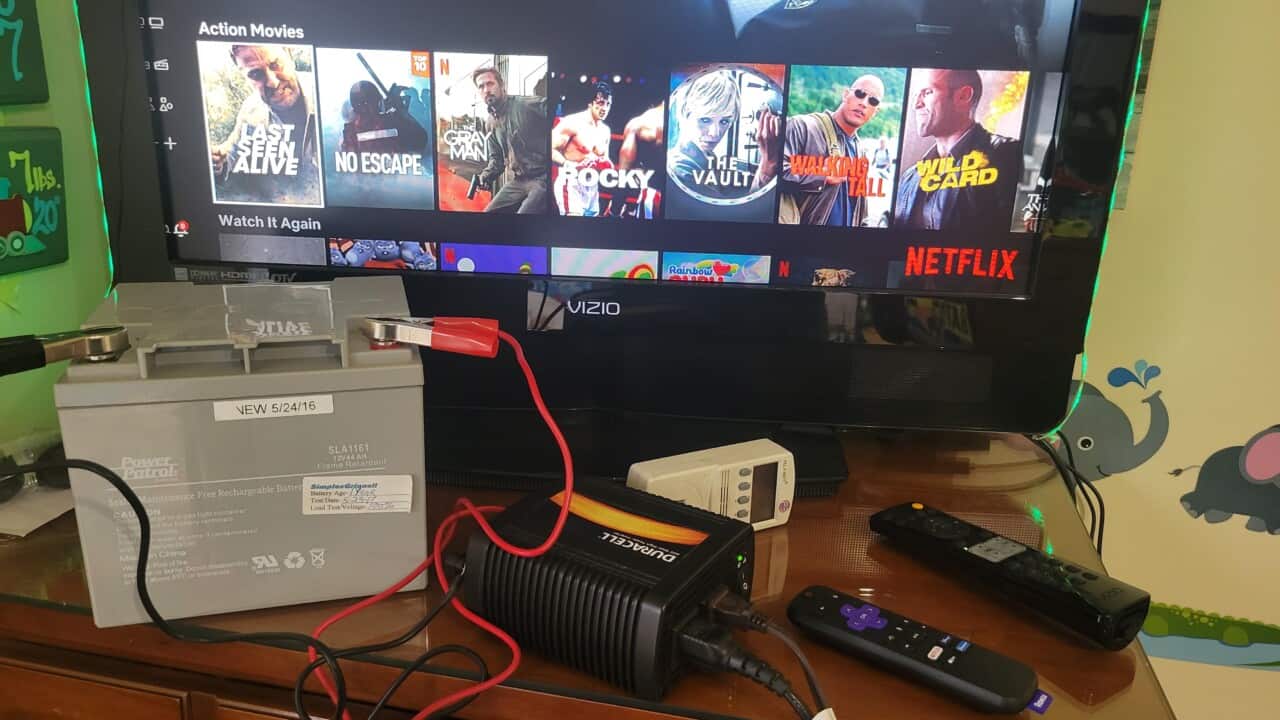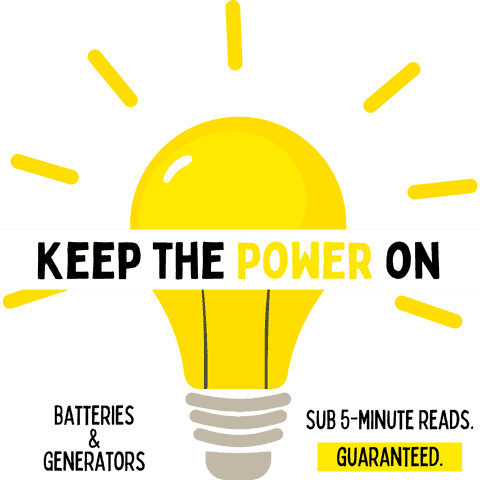Deep-cycle batteries, like those used for marine applications and golf carts, are excellent sources of alternative power for low draw applications like modern TV’s. They are quiet and can be discharged hundreds of times.
If you’ve never used a deep-cycle battery to power a TV, we’re going to very quickly cover how long you can do it, how to calculate it yourself, and how to do it safely.
Listen to the article below by hitting the play button below and feel free to scroll the page for any helpful visuals. All of the articles on this website will have this audio feature for your convenience.
How Long Can a TV be Powered with a Deep-Cycle Battery?
A typical 100Ah deep-cycle battery can power a mid-sized TV for about 20 hours until the battery is completely depleted.
Common sizes for deep-cycle batteries include 33Ah, 55Ah, 75Ah, 80Ah, 90Ah, 100Ah, and 105Ah. You can even achieve 190Ah, 215Ah, 220Ah, and 235Ah with two 6-volt, deep-cycle batteries that are hooked up in series for a 12-volt system.
The abbreviation “Ah” stands for “amp hours” or “ampere hours”. Basically it’s just a measurement that indicates how long the battery can power something if you know the amps being drawn.
A single 100Ah deep-cycle battery can theoretically power something that draws 1 amp for 100 hours, or something that draws 5 amps for 20 hours, 50 amps for 2 hours, and so on and so forth. In reality, it’s way more complex than that (like considering Peukert’s Law) but to keep things simple we’ll leave it there.

A typical television these days will run anywhere from 30-70 watts depending on the size. My 50″ ONN Roku TV in the living room hovers around 50 watts, for example. Another 32″ TV in the bedroom hovers around 35 watts.
A TV that normally runs off of grid power from your house will need an inverter to turn the battery’s 12-volt DC (direct current) power into usable 120-volt AC power (alternating current). The process of doing this will result in a 10-20% inefficiency, depending on the quality of your inverter.
Below is a table that outlines how long typical deep-cycle battery sizes can power small, medium, and large TV’s.
| Deep-Cycle Battery Size (Ah) | Time in Hours to Power a Small TV (35 watts) | Time in Hours to Power a Medium TV (50 watts) | Time in Hours to Power a Large TV (70 watts) |
|---|---|---|---|
| 33 | 9.6 | 6.7 | 4.8 |
| 55 | 16 | 11.2 | 8 |
| 75 | 21.8 | 15.3 | 10.9 |
| 80 | 23.2 | 16.3 | 11.6 |
| 90 | 26.2 | 18.3 | 13.1 |
| 100 | 29 | 20.4 | 14.5 |
| 105 | 30.6 | 21.4 | 15.3 |
| 190* | 55.2 | 38.7 | 27.6 |
| 215* | 62.6 | 43.8 | 31.3 |
| 220* | 64 | 44.8 | 32 |
| 235* | 68.4 | 47.9 | 34.2 |
If you need to do the calculations yourself, you can do the following easy math below.
Remember: amps x volts = watts
An example of the calculations above with a 100Ah battery, a 50-watt medium TV, and an inverter with a 15% inefficiency would be as follows:
100Ah x 12v = 1,200 watt hours –> 1,200 watt hours / (50-watts / 0.85) = 20.4 hours
How to Power a TV with a Deep-Cycle Battery?
Powering a TV with a deep-cycle battery requires an intermediary to convert the battery’s DC (direct current) power to the TV’s AC (alternating current) requirements.
To do that, we simply need a power inverter. For appliances like TV’s and things with sensitive electronics, it’s best to use a pure sine wave power inverter (Amazon) instead of a modified sine wave inverter.
A pure wave power inverter supplies the TV with electricity that is like the clean power from your wall outlets. The modified sine wave inverter supplies power that is choppier and not as smooth. In time, it can damage sensitive electronics, but until that happens I promise you that you’ll notice some sound issues with harmonic problems.

If your inverter has alligator clips, simply clip them to the appropriate battery terminal (black to negative, red to positive). Turn the inverter on and then plug in your TV into the inverter itself. That’s it!
If you need more of a permanent setup, you can certainly buy an inverter with cables that can be affixed to the terminals with a nut on the threaded battery terminal posts.
If you want to maximize the efficiency of the battery-to-TV connection, you can always purchase a 12-volt Direct Current TV and bypass the inverter itself. A DC TV like this (Amazon) can be powered by a battery with a simple 12-volt “cigarette lighter” plug like this. You’ll get more screen time that way since you won’t have the 10-20% loss in efficiency as the inverter switches the power type.
